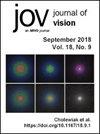Memory representations during slow change blindness.
IF 2
4区 心理学
Q2 OPHTHALMOLOGY
引用次数: 0
Abstract
Classic change blindness is the phenomenon where seemingly obvious changes that coincide with visual disruptions (such as blinks or brief blanks) go unnoticed by an attentive observer. Some early work into the causes of classic change blindness suggested that any pre-change stimulus representation is overwritten by a representation of the altered post-change stimulus, preventing change detection. However, recent work revealed that, even when observers do maintain memory representations of both the pre- and post-change stimulus states, they can still miss the change, suggesting that change blindness can also arise from a failure to compare the stored representations. Here, we studied slow change blindness, a related phenomenon that occurs even in the absence of visual disruptions when the change occurs sufficiently slowly, to determine whether it could be explained by conclusions from classic change blindness. Across three different slow change blindness experiments we found that observers who consistently failed to notice the change had access to at least two memory representations of the changing display. One representation was precise but short lived: a detailed representation of the more recent stimulus states, but fragile. The other representation lasted longer but was fairly general: stable but too coarse to differentiate the various stages of the change. These findings suggest that, although multiple representations are formed, the failure to compare hypotheses might not explain slow change blindness; even if a comparison were made, the representations would be too sparse (longer term stores) or too fragile (short-lived stores) for such comparison to inform about the change.慢变盲过程中的记忆表征
典型变化盲是一种现象,即看似明显的变化与视觉中断(如眨眼或短暂空白)同时发生时,细心的观察者却没有注意到这些变化。研究典型变化盲症原因的一些早期研究表明,任何变化前的刺激表征都会被变化后刺激的表征所覆盖,从而阻碍了变化的检测。然而,最近的研究发现,即使观察者确实保持了变化前和变化后刺激状态的记忆表征,他们仍然会错过变化,这表明变化盲也可能是由于未能比较存储的表征而引起的。在这里,我们研究了慢速变化盲(一种相关现象,即使在没有视觉干扰的情况下,当变化发生得足够慢时也会出现),以确定它是否可以用经典变化盲的结论来解释。在三个不同的慢速变化盲实验中,我们发现那些始终未能注意到变化的观察者至少有两种关于变化显示的记忆表征。其中一种表征精确但短暂:是对最近刺激状态的详细表征,但很脆弱。另一种表征持续时间较长,但相当笼统:稳定但过于粗糙,无法区分变化的各个阶段。这些研究结果表明,尽管形成了多种表征,但无法对假设进行比较可能无法解释慢变盲症;即使进行了比较,表征也会过于稀疏(长期储存)或过于脆弱(短期储存),这种比较无法提供有关变化的信息。
本文章由计算机程序翻译,如有差异,请以英文原文为准。
求助全文
约1分钟内获得全文
求助全文
来源期刊

Journal of Vision
医学-眼科学
CiteScore
2.90
自引率
5.60%
发文量
218
审稿时长
3-6 weeks
期刊介绍:
Exploring all aspects of biological visual function, including spatial vision, perception,
low vision, color vision and more, spanning the fields of neuroscience, psychology and psychophysics.
 求助内容:
求助内容: 应助结果提醒方式:
应助结果提醒方式:


